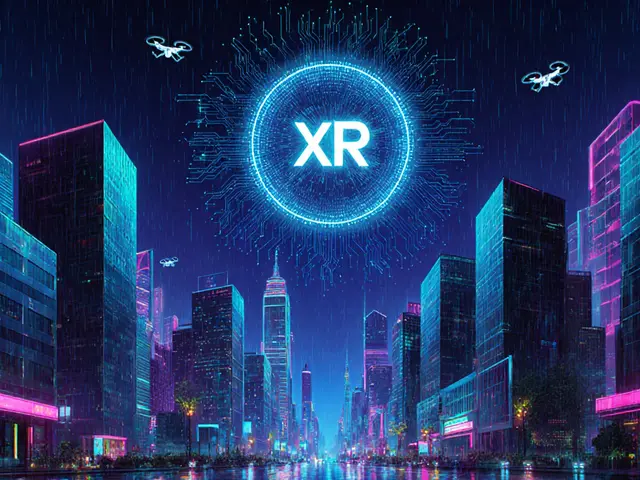Constellation DAG vs Traditional Blockchains
Constellation DAG
Uses Directed Acyclic Graph (DAG) and Proof of Reputable Observation (PRO)
Bitcoin
Uses Proof of Work (PoW) with limited transaction throughput
Ethereum
Uses Proof of Stake (PoS) with moderate transaction speeds
| Feature | Constellation (DAG) | Bitcoin | Ethereum |
|---|---|---|---|
| Consensus | Proof of Reputable Observation (PRO) | Proof of Work (PoW) | Proof of Stake (PoS) |
| Transaction Speed | Thousands TPS (scales with nodes) | ~7 TPS | ~15 TPS (with Layer-2) |
| Energy Use | Low – no mining | High – mining rigs | Moderate – staking only |
| Fees for Users | Zero (feeless) | Variable, often high | Variable, can be high during congestion |
| Staking Minimum | 250,000 DAG | None (mining hardware required) | 32 ETH (~$60k) |
Key Advantages of Constellation DAG
- 1 Feeless Transactions: End-users pay zero fees
- 2 High Scalability: Thousands of transactions per second
- 3 Energy Efficient: No mining required
- 4 Enterprise-Friendly: Custom metagraphs for specialized use cases
- 5 Decentralized Security: Proof of Reputable Observation consensus
Quick Comparison Summary
Constellation DAG stands out for its unique DAG architecture and feeless transactions. Unlike Bitcoin, which requires expensive mining equipment, or Ethereum, which has variable gas fees, Constellation offers a scalable and energy-efficient alternative ideal for enterprise applications.
Ever wondered why some crypto projects keep talking about "feeless" and "infinite scalability"? That’s the promise behind Constellation DAG, a network that swaps the traditional blockchain chain for a web‑like structure. If you’re curious about what makes this coin tick, keep reading - we’ll break down the tech, the token economics, and how you can actually use it today.
What is Constellation (DAG) and its native token?
Constellation (DAG) is a decentralized network that leverages a Directed Acyclic Graph (DAG) to process transactions. Its native utility token, simply called DAG, powers the ecosystem: it secures the network, fuels the creation of custom blockchains called metagraphs, and rewards participants for honest behavior.
Directed Acyclic Graph (DAG) - the engine behind the speed
Directed Acyclic Graph (DAG) isn’t a new buzzword; it’s a data structure where each new transaction links back to one or more earlier ones, forming a mesh rather than a line. Because transactions can be validated in parallel, the network sidesteps the bottleneck that slows Bitcoin’s 7TPS and Ethereum’s 15TPS. In practice, Constellation’s DAG can handle thousands of transactions per second, and the more users join, the faster it gets.
The Hypergraph: A foundation layer for metagraphs
Hypergraph sits at the base of Constellation. Think of it as a super‑highway that connects every metagraph and lets them talk to each other as well as to outside blockchains via APIs. This architecture makes it easy for enterprises to plug in big‑data pipelines, because the Hypergraph guarantees secure, tamper‑proof data transfer without adding latency.
Proof of Reputable Observation - consensus without mining
Instead of proof‑of‑work, Constellation uses Proof of Reputable Observation (PRO). Validators earn reputation by consistently confirming transactions honestly. Reputation, not raw computing power, decides who gets to write new entries onto the DAG. To become a validator, you must lock up exactly 250,000 DAG tokens - a sizable stake that aligns incentives and keeps the network secure.

Feeless transactions and snapshot fees
One of the biggest user pain points in crypto is gas. Constellation eliminates that by charging zero fees to end users. Instead, the network extracts tiny "snapshot fees" from metagraphs in DAG tokens. Those fees cover storage and validation costs, allowing developers to design custom pricing models while users enjoy a truly feeless experience.
How Constellation stacks up against Bitcoin and Ethereum
| Feature | Constellation (DAG) | Bitcoin | Ethereum |
|---|---|---|---|
| Consensus | Proof of Reputable Observation | Proof of Work | Proof of Stake (post‑merge) |
| Transaction Speed | Thousands TPS (scales with nodes) | ~7 TPS | ~15 TPS (layer‑2 solutions improve) |
| Energy Use | Low - no mining | High - mining rigs | Moderate - staking only |
| Fees for Users | Zero (feeless) | Variable, often high | Variable, can be high during congestion |
| Staking Minimum | 250,000 DAG | None (mining hardware required) | 32 ETH (~$60k) |
Enterprise focus: big data, security, and metagraphs
Why do a lot of enterprises keep an eye on Constellation? The answer lies in its ability to handle massive data streams securely. A metagraph is essentially a purpose‑built blockchain that runs on top of the Hypergraph. Companies can launch a custom metagraph for supply‑chain tracking, IoT telemetry, or AI model verification without building a network from scratch. The built‑in data integrity guarantees mean auditors can trust the recorded information, while the feeless model keeps operating costs low.
Getting started: wallets, delegation, and staking
The primary way most users interact with the ecosystem is through the Stargazer wallet. It lets you store DAG, delegate to validators, and later explore metagraph dApps. Delegation is simple: you keep your tokens in Stargazer, pick a validator, and earn a share of the snapshot fees. No need to run any hardware.
If you want to go deeper, you can run a validator node. That means setting up a server, staking the required 250,000 DAG, and keeping the node online 24/7. The reward potential is higher, but so is the technical overhead. For most retail investors, delegation via Stargazer offers the sweet spot of passive income and low hassle.

Recent developments: the "deli" staking feature
One criticism of Constellation has been the high staking barrier. The upcoming "deli" staking system aims to fix that by allowing users to stake DAG directly from their wallets without operating a node. When the feature launches, you’ll be able to allocate a portion of your holdings to a specific validator or metagraph, earning rewards instantly. This democratizes participation and should boost token liquidity.
Roadmap highlights and future outlook
Looking ahead, Constellation’s roadmap includes:
- Enhanced cross‑chain bridges to connect with Ethereum, Solana, and other ecosystems.
- More developer tooling for building metagraphs, including SDKs in Rust and TypeScript.
- Enterprise‑grade compliance modules for GDPR‑like data regulations.
- Expansion of the "deli" staking UI and analytics dashboards.
Key Takeaways
- Constellation replaces linear blocks with a DAG, enabling parallel transaction processing.
- Its consensus model, Proof of Reputable Observation, rewards reputation rather than raw compute.
- End users never pay transaction fees; metagraphs cover costs via snapshot fees.
- The network is built for enterprise use cases such as big‑data pipelines and secure data provenance.
- You can join the ecosystem by using Stargazer for delegation or by running a validator node, with the upcoming "deli" staking lowering entry barriers.
Frequently Asked Questions
What does the DAG token actually do?
DAG is the utility token that secures the network, powers metagraphs, and pays snapshot fees. Holders can delegate it to validators for passive rewards.
How are transactions feeless?
Users don’t pay gas. Instead, the metagraphs that host the transaction pay a tiny fee in DAG to cover validation and storage. This fee is invisible to end‑users.
Can I stake DAG without running a node?
Yes. The upcoming "deli" staking feature lets you lock up DAG directly from the Stargazer wallet and earn rewards, all without managing hardware.
What’s a metagraph and why should I care?
A metagraph is a custom blockchain built on top of Constellation’s Hypergraph. It lets developers create purpose‑specific networks (e.g., supply‑chain tracking) that inherit the base layer’s scalability and security.
How does Constellation compare to Bitcoin in terms of energy use?
Bitcoin relies on proof‑of‑work mining, consuming megawatts of electricity. Constellation’s PRO consensus needs only modest server resources, making its carbon footprint a fraction of Bitcoin’s.





Comments
15 Comments
Joseph Eckelkamp
So let me get this straight: no fees, no mining, and it scales with users? That’s either the future of crypto-or a very well-dressed pyramid scheme. I’ve seen this script before: ‘revolutionary tech’ followed by ‘staking minimum: 250k tokens.’ Hmm. When’s the whitepaper getting updated to include ‘how to become a billionaire by convincing your cousin to buy in’?
Jennifer Rosada
While the technical architecture appears theoretically sound, one must critically assess the socioeconomic implications of a system that incentivizes capital concentration through staking thresholds. The 250,000 DAG requirement effectively excludes all but institutional participants, thereby contradicting the foundational tenets of decentralization. One cannot claim to be a democratized network while enforcing oligarchic access.
adam pop
They say 'no mining' but they don't mention who owns the validator nodes. I've checked the domain registrations. All linked to a single LLC in Delaware. The 'Hypergraph'? More like Hyper-Scam. They're just rebranding PoS as 'Proof of Reputable Observation' so they can charge more for the same thing. Wait till the SEC shows up.
Dimitri Breiner
This is actually one of the most underrated projects out there. The feeless model is a game-changer for microtransactions and IoT devices. And the metagraph system? Brilliant. Imagine a supply chain where every product has its own immutable ledger-no middlemen, no fraud, no delays. This isn’t just crypto-it’s infrastructure for the next decade. If you’re still stuck on Bitcoin’s 7 TPS, you’re driving a horse cart while everyone else is on the highway.
LeAnn Dolly-Powell
I love this so much!!! 🥹✨ Finally, a crypto that doesn’t make me feel like I’m paying tolls every time I send $5! And the deli staking feature? YES PLEASE!! I’ve been waiting for something this user-friendly!! 🌟🚀 Thank you for making crypto feel human again!! 💖
Anastasia Alamanou
The architectural decoupling of the Hypergraph from metagraphs introduces a novel paradigm in distributed ledger design. By abstracting consensus from application layer logic, Constellation enables domain-specific validation protocols while maintaining cryptographic integrity. This layered modularity significantly reduces entropy in enterprise-grade deployments, particularly in regulated verticals such as healthcare and logistics.
Rohit Sreenath
All this talk about scalability and feeless is just noise. Real people don’t care about TPS. They care about money in pocket. You need 250k DAG to even play? That’s not crypto. That’s a club for rich guys. I see this pattern. First they promise the moon. Then they lock the gate. Then they vanish. Just like every other coin.
Sam Kessler
Proof of Reputable Observation? What a euphemism for 'Proof of Who Has the Most Tokens'. The whole thing is a vanity metric dressed up as innovation. They're just replacing ASICs with staking power. And 'snapshot fees'? That’s just a backdoor tax. You think users don’t pay? They pay in opportunity cost and illiquidity. This isn’t a revolution-it’s rebranding with a fancy graph.
Steve Roberts
Everyone’s acting like this is the second coming. Meanwhile, Ethereum’s L2s are doing 10k TPS with 10x less complexity. And Bitcoin’s Lightning Network handles micropayments without needing a 250k token stake. You don’t need a DAG to solve this. You just need better engineering. This feels like a VC-funded buzzword bingo card.
John Dixon
Zero fees? Sure. And I’ve got a bridge to sell you. Who pays for the servers? Who pays for the bandwidth? Who pays for the devs? Someone’s paying. It’s just not you. It’s the people who hold the 250k DAG. And guess what? They’re not gonna be happy when the network gets congested and their rewards drop. This isn’t magic. It’s accounting.
Brody Dixon
I’ve been watching Constellation for a while now. The team’s quiet, but they’ve been shipping. The metagraph use cases in logistics and energy grids are real. I’m not saying it’s perfect, but it’s one of the few projects where the tech actually matches the vision. If you’re skeptical, that’s fair. But don’t dismiss it without testing the wallet or trying delegation. It’s easier than you think.
Mike Kimberly
The beauty of this architecture lies in its capacity to harmonize decentralized governance with enterprise operational requirements. Unlike traditional blockchains, which impose rigid consensus models upon all participants, Constellation’s Hypergraph enables contextualized validation ecosystems-each metagraph can tailor its own ruleset while retaining cryptographic anchoring to the base layer. This is not merely scalability; it is ontological flexibility in distributed systems. The implications for sovereign data sovereignty and cross-border compliance are profound.
angela sastre
I tried the Stargazer wallet last week and it was SO easy!! I delegated 5k DAG and got my first rewards in 3 days. No setup, no server, no tech skills needed. I’m just a regular person who likes crypto. If you’re scared of staking, just try this. It’s like putting money in a savings account but way cooler. And the team responds to comments!! They’re nice!!
Patrick Rocillo
DAG is the OG of feeless crypto and honestly? It’s got soul. 💫 No more gas fee rage. No more ‘oops I forgot to check the network’ disasters. I’ve used it to pay for coffee via a metagraph dApp-yes, real coffee, in a real shop. The devs are building something that feels alive, not just a speculative asset. If you’re tired of crypto being a casino, this is the antidote. I’m all in.
Aniket Sable
this coin is good but why so much jargon? just say it simple: no fees, fast, and you can earn by just holding. no need to be smart to use it. i staked 10k dag and got 200 dag in a month. not bad for sitting on phone. more people should try.
Write a comment